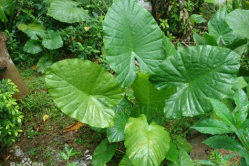As wild vegetables grow luxuriantly, many people like to go outdoors to pick and taste wild vegetables. However, roadside wild vegetables should not be picked and eaten casually, and the following tips should be kept in mind:
Avoid picking unfamiliar wild vegetables & be aware of toxic plants
In Guangdong, common wild vegetables include dandelions, Ku Mai Cai (Ixeris denticulata), white mugwort, and shepherd's purse. However, some toxic varieties look very similar to these wild vegetables.
Hemlock has grooves on the stem, dark red spots underneath, and small white flowers. It smells bad and has a toxic component called cicutoxin that is found throughout the plant, with the roots being the most toxic. Ingesting 10 grams of it can be fatal to children, and it is highly toxic to mammals, with reports of animal poisoning from consuming hemlock worldwide.

Hemlock.
Thorn Apple is a tall plant, about 0.5-1.5 meters high. The entire plant is toxic, with the highest toxicity in its seed. Toxic substances include scopolamine and atropine. Both consumption and external application of its leaves can cause systemic poisoning, and symptoms usually appear after 30 minutes of consumption, with mostly an acute and sudden onset.

Thorn Apple.
Dripping guanyin is a large evergreen herbaceous plant in the Araceae family. The sap of its stem and leaves is toxic, which can cause numbness and swelling of the tongue, central nervous system poisoning, and contact with the skin can cause itching, numbness, and rash.

Dripping guanyin.
Avoid picking wild vegetables in polluted areas
When picking wild vegetables, don’t choose areas where there may be pollution in the environment, such as highways, sewers, and chemical plants. Also, be careful when picking wild vegetables in farmland or parks, where pesticides may have been sprayed. Even if wild vegetables grow well in these areas, their safety for consumption cannot be guaranteed.
Furthermore, when picking wild vegetables, it is essential to protect the ecology by not over-picking plants in the same area. If the wild vegetable has a root system, it is best to leave it intact instead of uprooting it.
Be cautious when consuming wild vegetables
After picking wild vegetables, clean them thoroughly and don’t store them for long periods.
As for whether eating wild vegetables will cause adverse reactions, it not only depends on the type of vegetable and the amount consumed, but also on the individual’s physical conditions.
Some people may be allergic to wild vegetables.
What should you do if food poisoning occurs after eating wild vegetables?
If you have symptoms of poisoning, such as dizziness, nausea, abdominal pain, and diarrhoea after eating wild vegetables, stop eating immediately.
Use fingers or other tools to induce vomiting in time.
Take the remaining wild vegetables and vomit and seek medical treatment in time.
Author | Hannah, Li Fuying (intern)
Editor | Wing, Nan, Monica, James
Source | Guangdong Provincial Center for Disease Control and Prevention
















